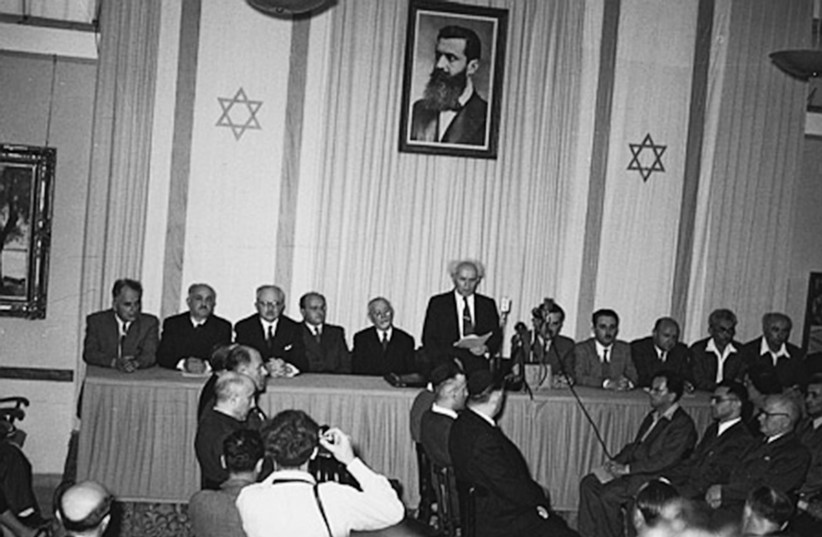A two-state solution to the Israel-Palestinian conflict, long the dream of Jewish liberals like me, is increasingly unlikely and probably has been since the end of the Six-Day War in June 1967 – a war in which Israel expelled Jordanian forces from the West Bank.
Prior to the Jordanian exit, there was a two-state solution of sorts – a Jewish state (Israel) and an Arab state (Jordan) occupying the entirety of what had been Mandatory Palestine.
A short time later Israel’s government, headed by Labor Party prime minister Levi Eshkol, offered to return the West Bank to Jordan in exchange for peace, an offer Jordan rejected and concurrently abandoned its claim to the West Bank in favor of the newly created Palestine Liberation Organization (PLO).
Jordan’s rejection made a two-state solution an impossible dream that was not shared by the two ethnicities, each with legitimate claims to the same land. Looking back, we should have known then that a two-state solution was no longer a realistic option.
Since 1967, hundreds of thousands of Israeli Jews (“settlers”) have moved to the West Bank for economic, religious, ideological, or other reasons. The numbers will certainly continue to grow, making a two-state solution a faded dream.

The history of Jews, Israel, and conflicts with Palestinians and Arabs
Looking back at the decade leading up to Israel’s Declaration of Independence in 1948, the Arab side rejected all international proposals for the creation of a Jewish state in Mandatory Palestine.
The Arab world believed it could block the creation of a Jewish state in a region with more than 100 million Arabs and a minuscule number of Jews. In doing so the Arab side ignored the fact that Palestine had been governed for centuries not by Arabs but by a non-Arab country, Turkey and that the 600,000 Jews living in Mandatory Palestine had for a decade been building the foundations (including military) of an eventual Jewish state.
History is replete with examples of a greater military power overwhelming native populations. We Americans are living on land that was the home of Native Americans, not the property of our largely European ancestors. The American slogan “Manifest Destiny” was far more chauvinistic than the Zionism anthem “Hatikvah” (The Hope).
Since Jordan’s exit from the West Bank in 1967, no Palestinian Arab leader has been willing to agree to a two-state solution, even when the Israeli side offered to withdraw from 97 percent of the West Bank.
There are those who blame weak Arab leadership for the failure of the peace process, but it is unlikely that Israel would have stood by idly and watched a charismatic Palestinian Arab leader aka Yasser Arafat take power in the West Bank. Hamas won the last free election in the West Bank in 2006.
Driven out of the West Bank by the PLO, Hamas is now isolated in the Gaza Strip, launching rocket attacks against Israel. No Israeli government could tolerate similar attacks from the West Bank.
Jewish claims to the West Bank have their roots in history. According to the Bible, the exiles from Egypt entered the Promised Land from the east through Jericho, now in Zone A under Palestinian administrative and police control in keeping with the 1993 Oslo Accords. So too Hebron (Kiryat Arba), the scene of early Jewish presence is now the theater of reoccurring clashes between Jewish settlers and Arab inhabitants.
It is common for liberals like me to blame Israel’s Likud and right-wing extremists for the burgeoning settlements on the West Bank, but the settlements began in 1975 under then-defense minister Shimon Peres.
At that time the settlements were justified by their supporters on the basis of military significance and later as bargaining chips in future negotiations for a two-state solution. Both rationales were abandoned with the more extensive settlement activity in the 1980s.
No one knows what the future holds, but all signs point to an expanded status quo that may be more of a reality than a solution. As long as Israel does not annex the West Bank, its Arab inhabitants will not have the right to vote in Israeli elections, thereby preserving the dream of Theodor Herzl (the founder of the Zionist movement) that the new Jewish state in Palestine will be both Jewish and democratic.
With no two-state solution in sight, Israel’s attention should turn to an improvement in the lot of its Arab citizens. Looking out from my home in South Tel Aviv, I can see construction cranes reaching to the sky while Arab villages languish, looking much as they did 50 years ago (with primitive roads, sanitation, and other services). Israel can point with pride to the number of Arab students in its universities, particularly in its graduate schools, as well it should. But there are clear differences between the living conditions of Israel’s Jewish and Arab citizens, a gap that will likely attract increased public attention and Arab unrest with the ever-growing reality that there will not be a two-state solution. ■
The author, a prominent Jewish leader, former American ambassador and White House special counsel lives in Washington, DC, with a home in Israel. He recently purchased the Codex Sassoon Bible and donated it to the ANU Museum of the Jewish People in Tel Aviv.
